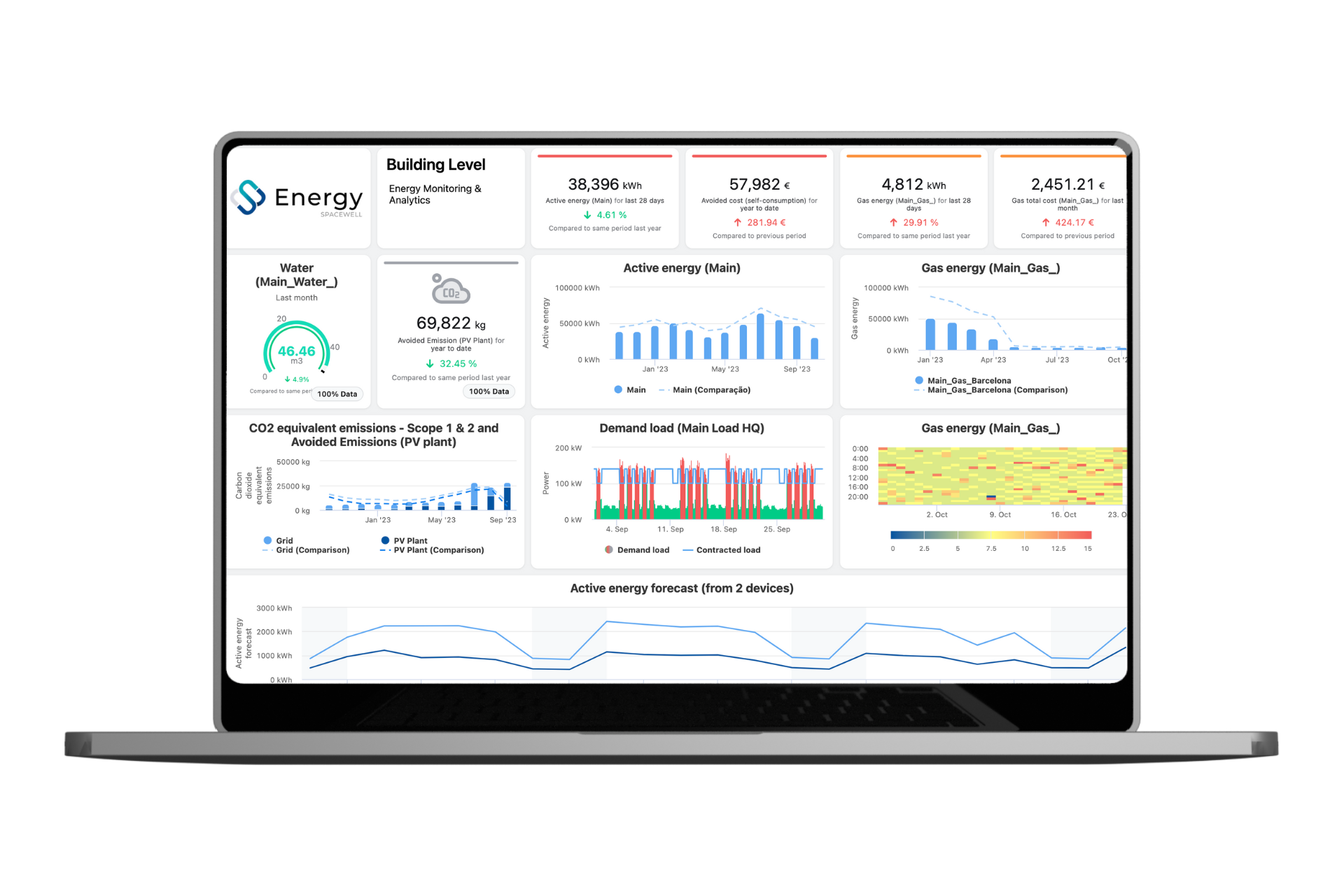Today, it is essential to make data-driven decisions. That’s why measuring energy efficiency with reliable tools will allow you to assess the real impact of your work and enable you to make the right decisions for your project. Always based on measurable, quantifiable and real data.
Our latest guide explores different approaches that, as a Facility Manager, will help you to measure and understand the energy savings you can achieve in your facilities through the methods that emerge from Energy Management Systems.
If achieving energy efficiency, reducing operating costs and saving energy are key objectives for your organisation and you want to take a step towards sustainability, this article is for you.
Read on to find out how to implement IPMVP protocols, why energy meters are useful, what Life Cycle Cost Analysis is for, and more.
Measuring Energy Savings and Cost Reduction in Facilities Management
There are several methods to measure energy savings resulting from the use of an Energy Management System (EMS) and the adoption of energy efficiency practices. Some ways to accurately determine the amount of energy saved include the use of energy meters, analysis of utility bills and the use of software analysis.
1) Energy Meters
Energy meters are tools designed to measure the amount of energy used in your facility. They’re useful for keeping tabs on energy consumption both before and after implementing energy-efficient measures. A specific type of energy metre, called interval meter analytics, goes even further by analysing data at intervals of an hour or less.
2) IMPVP Protocol
The Facilities Management sector places a great deal of importance on the International Performance Measurement and Verification Protocol (IPMVP) for a few reasons. The IPMVP is a standardised method for evaluating the effectiveness of energy efficiency and sustainability projects across different facilities. By offering a structured framework, it helps you, the Facility Manager, accurately assess how well your energy-saving initiatives, such as upgrading equipment, improving buildings, and refining day-to-day operations, are truly performing.
Beyond its role in ensuring transparency and dependability in energy-related projects, the IPMVP also equips decision-makers with credible data, enabling them to make well-informed choices regarding the allocation of resources and future planning. In the grand scheme of things, the IPMVP encourages a more effective and thoughtful utilisation of resources, leading to cost savings and the promotion of environmentally conscious practices.
3) Software Analytics
Energy management software takes in and analyses data from various sources like sensors, weather predictions, and building automation systems. It can perform in-depth analyses to address concerns related to utility bills, energy-saving initiatives, energy wastage, and other operational factors.
This software plays a pivotal role in transforming raw data into actionable insights. Through advanced algorithms and machine learning, it can uncover hidden patterns and correlations in the data, providing a deeper understanding of energy consumption and efficiency. Moreover, the software can identify anomalies or irregularities, helping in the early detection of energy wastage or system malfunctions.
One of the significant advantages of energy management software, such as the Spacewell Energy Platform, is its capability to generate comprehensive reports (see the picture below). These reports allow you to compare different loads, and assess energy use across equipment types, timeframes, facilities, and more. This granular level of analysis helps you pinpoint the times when your facilities consume the most energy, and it provides detailed explanations of where and how energy is used within your facilities.

In summary, energy management software, with its powerful analytics capabilities, empowers organisations to turn complex and vast energy data into actionable intelligence. This, in turn, enables more precise and efficient energy management, leading to cost savings and a reduced environmental footprint.
4) Life Cycle Cost Analysis
Life Cycle Cost Analysis (LCCA) is a method of assessing all the expenses related to owning and using a building or its systems over its entire lifespan. This includes everything from buying it to maintaining it and eventually getting rid of it.
LCCA is particularly valuable when you have different options for a project that meet the same performance requirements but vary in terms of their initial and ongoing expenses. This analysis helps in comparing these options to identify the one that provides the highest overall cost savings.
For example, imagine you’re deciding between two different HVAC systems for a building. One system might be more expensive to install but is more energy-efficient, resulting in lower monthly operating costs. LCCA would help you determine if the higher initial cost is justified by the savings in operating expenses over time. It’s a way of making informed decisions that balance both immediate and long-term financial considerations in building projects.
Additionally, LCCA can take into account various factors such as energy efficiency incentives, maintenance and repair costs, and even the environmental impact of the systems being considered. By including these elements in the analysis, it allows for a comprehensive evaluation of the long-term economic and environmental implications of different choices.
Incorporating Life Cycle Cost Analysis into building projects provides a holistic perspective, guiding decision-makers in striking a balance between immediate financial considerations and the long-term economic and environmental sustainability of the chosen options. It’s a method that goes beyond mere cost comparison, helping in the selection of building systems that not only save money over time but also contribute to a greener and more efficient future.
Conclusion
It is clear that optimal management of energy resources is imperative to achieve energy efficiency. Accurate measurement of these resources is essential to make effective decisions in line with your energy savings and sustainability goals.
The methods developed above are fundamental pillars for measuring and monitoring your energy consumption. With the data obtained from this monitoring, you will be able to detect weak points. You will then see where you have room for improvement, compare procedures and finally choose the option that best suits your situation.
Saving energy and therefore reducing your operating costs and making your facilities more sustainable is possible thanks to accurate analysis with the methods that emerge from Energy Management Systems, such as the Spacewell Energy (Dexma) Platform.
Download the free guide to learn more!

![Optimise Efficiency and Reduce your Energy Costs in Facilities Management [Guide] | Spacewell Energy](https://no-cache.hubspot.com/cta/default/437281/13d31898-b6c2-4ba6-b9f4-6905777baeee.png)
![Optimise Efficiency and Reduce your Energy Costs in Facilities Management [Guide] | Spacewell Energy](https://no-cache.hubspot.com/cta/default/437281/11de7e72-49d2-407b-8b12-7340673e7d4b.png)

